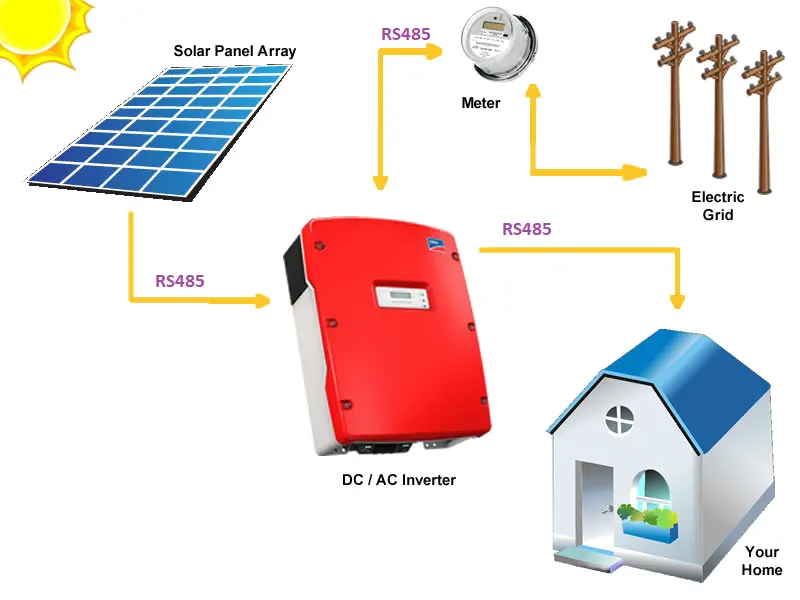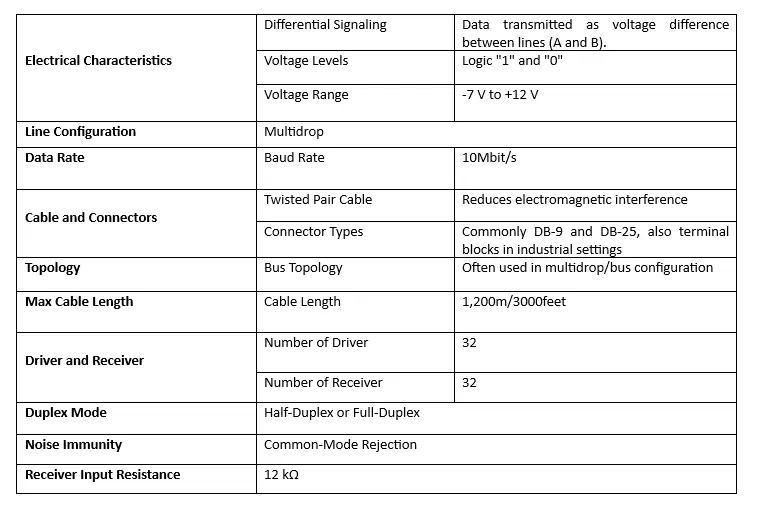In the world of industrial automation, the RS485 serial communication protocol has played a crucial role for several decades. This tutorial aims to provide a comprehensive understanding of the basics, working, and applications of the RS485 protocol. So, let’s get started!
You may also like reading:
- How to interface Raspberry Pi Pico with RS485 Protocol
- Introduction to RS232 Serial Communication Protocol
- How to interface Arduino with RS232 communication protocol
- How to interface esp32 with rs485 (Modbus) sensors with example code
- Multiple ESP32 Communication via RS485
- How to interface Arduino with RS485 (Modbus) protocol
- How to interface Modbus RTU (RS485) sensors with Arduino
What is RS485?
RS485 is a serial communication protocol. It is one of the most widely used communication protocols, especially in noisy industrial areas. Two devices can communicate with each other over a long distance (up to 1200m) using RS485 communication. Unlike RS232, RS485 has a 10 mbit/s data transfer rate. Lastly, it is master-slave communication so that each slave can communicate with the master. For each master, you can assign up to 32 slaves.

Why we need RS485 based Communication?
Firstly, in a large factory area, device-to-device communication is very challenging because the normal communication protocol can only handle a few meters; after that, data is destroyed and the data transfer rate is significantly reduced. To overcome this, RS485 is one of the best solutions because two or more devices can communicate up to 1200m with a 10 mbit/s high seed data transfer rate.
Secondly, an industrial area is a noisy area. The RS485 receiver decodes signals by comparing the voltage differences between its two wires. Although common-mode noise has limited influence on transmission due to the differential nature of the signal, it can still effectively corrupt data transmitted over the RS485 bus. Therefore, using RS485 communication, noise can be significantly reduced.
Finally, RS485 supports both half-duplex and full-duplex communication modes. In half-duplex communication mode, master and slave do not communicate simultaneously, which means master or slave send or receive data in one direction at a time. On the other hand, in full-duplex mode, master and slave send and receive data in both directions at the same time or simultaneously.
Applications of RS485 Communication Protocol
Industrial Automation
RS-485 is extensively used in industrial automation systems for communication between programmable logic controllers (PLCs),HMI,VFD, sensors, and other devices. Its noise immunity and long-distance capabilities make it ideal for harsh industrial environments

Data Acquisition Systems
RS-485 is used in data acquisition systems where sensors and data loggers need to communicate over extended distances. Its ability to support multiple devices on the same bus makes it suitable for collecting data from distributed sources.

Access Control Systems
Access control systems, including card readers, biometric scanners, and door controllers, often utilize RS-485 for communication. This enables secure and reliable data transmission between different access control components.

Solar Power Systems
RS-485 is used in solar power systems for communication between solar inverters, energy meters, and monitoring systems. It allows for the integration and coordination of various components in a solar energy setup

Medical Equipment
Some medical devices and equipment use RS-485 for communication between different modules or components. Its noise immunity is crucial in medical environments where electromagnetic interference can be a concern.
Networking Equipment
RS-485 is also used in networking equipment, such as serial communication servers, to enable communication between devices in industrial networks.
Working Principle of RS485 Communication
In RS232 communication, the transmitter and receiver compare the voltage level with a common zero level. Due to this common zero or ground-line noise, it can easily have an effect on the signal line. But RS485 does not use the common zero level; instead, it uses +signal and -signal lines. This is also called differential signal communication. For example, if one signal is +5V, then the other signal line should be -5V.
This method allows us long-distance communication with RS485. Also, this differential signal communication provides us with less noise because both +signal and -signal lines are affected by the same noise, and this noise will cancel out from output signal.
Using RS485 communication, you can define one master and up to 32 slaves. Each slave has a slave ID. Master sends the data into the common two data lines A (+signal) and B (-signal) with slave addresses. The A and B lines are connected to all the slaves. If the slave ID is matched with the sending slave address, which comes from the master, then this particular slave will receive those data and send a response. The given picture demonstrates the whole process.

Full Specifications of RS485

Difference between RS485 and RS232 Communications
Now move into the difference between RS-232 and RS-485 which helps you to choose suitable for your project.RS-232 and RS-485 are both serial communication standards, but they differ in several key aspects. RS-232 uses single-ended signaling with voltage levels ranging from -15V to +15V, supporting point-to-point connections over relatively short distances. In contrast, RS-485 utilizes differential signaling with voltage levels from -7V to +12V, enabling multidrop configurations over longer distances using twisted pair cables.
RS-232 is commonly employed for short-distance communication between a computer and peripherals, while RS-485 is widely used in industrial settings for longer-distance communication between multiple devices. RS-232 is unidirectional and suited for one-to-one connections, whereas RS-485 supports multidrop or daisy-chain topologies, accommodating communication with multiple devices on the same bus.
RS-485 often requires termination resistors to minimize signal reflections, and its better common-mode rejection makes it more resilient in noisy environments. The choice between RS-232 and RS-485 depends on factors such as distance, number of devices, and environmental conditions. A table is shown the basic difference between RS-232 and RS-485.

RS485 Cables
Twisted Pair Cable

Selecting the right twisted pair cable is crucial for RS-485 communication. The cable’s twisted pairs reduce interference, and matching impedance (around 120 ohms) is essential. Choose an appropriate category (e.g., Cat 5e), consider shielding for high interference, and use termination resistors. Factor in distance, flexibility, and durability, ensuring compatibility with RS-485 connectors (e.g., DB-9, DB-25) for reliable performance.
Advantage of RS485 Communication
RS-485 offers several advantages, making it a popular choice for communication in various industrial and commercial applications:
Long Communication Distances:
RS-485 supports longer communication distances compared to many other serial communication standards. It can reliably transmit data over several thousand feet or meters, making it suitable for large industrial installations.
Multidrop Configuration:
RS-485 supports multidrop configurations, allowing multiple devices to be connected to the same communication bus. This enables the creation of complex networks with a single communication line.
High Data Rates:
RS-485 supports a wide range of data rates, from a few hundred bits per second to several megabits per second. This flexibility makes it suitable for applications with varying speed requirements.
Differential Signaling:
The use of differential signaling in RS-485, where data is transmitted as the voltage difference between two lines, provides better noise immunity and reduces the impact of common-mode interference.
Robust Performance in Noisy Environments:
RS-485 is well-suited for use in electrically noisy environments common in industrial settings. Its differential signaling, along with the option for shielded cables, helps maintain reliable communication in the presence of interference.
Half-Duplex or Full-Duplex Operation:
RS-485 supports both half-duplex and full-duplex communication. In half-duplex mode, devices can either transmit or receive at a given time, while full-duplex mode allows simultaneous transmission and reception on separate pairs.
Wide Industry Adoption:
RS-485 has been widely adopted in industrial and building automation, HVAC systems, process control, and other applications. Its acceptance as an industry standard contributes to the availability of compatible devices and components.
Cost-Effective Networking:
Building RS-485 networks is cost-effective, especially for applications where long distances and multiple devices need to be connected. The simplicity of the standard contributes to lower implementation costs.
Conclusion
In summary, RS-485 is a versatile communication standard known for its long-distance capabilities, multidrop support, and robust performance in noisy environments. Its simplicity, cost-effectiveness, and interoperability make it a widely adopted choice for industrial and commercial applications where reliable and resilient communication is essential.
